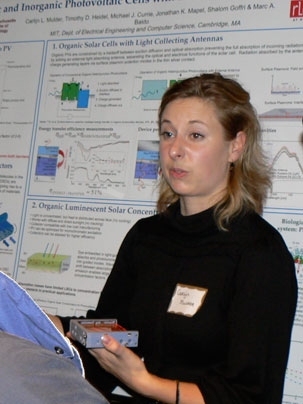More than 1,200 people showed up Friday night at the MIT Museum to learn about the latest developments, and the most promising new research efforts, in creating new energy technologies and improving the established ones.
Energy Night, organized by the student-run MIT Energy Club and Sloan Energy and Environment Club, showcased more than 40 different projects, clubs and businesses that are pushing the frontiers of research on energy in and around the campus. In addition to posters, displays and demonstrations of energy technologies, the social event featured drinks, hors d'ouevres and a live jazz band.
"Energy Night was fantastic," said Energy Club co-president Lara Pierpoint. "There was a lot of student excitement, a record number of nuclear-related posters, and the usual great music and food. I know that the Energy Conference team was highly successful in recruiting volunteers, and that the electric vehicle team got a lot of attention."
Outside the museum's doors, visitors were treated to inside-and-out views of three electric vehicles: A new fuel-cell car from Honda called FCX Clarity, which is being sold only in California, along with two different versions of custom cars built by the MIT Solar Electric Vehicle team. The team's original solar car has competed in past solar car races, and a newer version is in the process of being finished in preparation for a trans-Australia solar race next year.
Other groups highlighted a range of research projects being carried out now at MIT, including ongoing development of a new type of concentrating solar cell based on coatings that can be applied to existing windows to redirect much of the light to the edges of the glass, where small solar cells can be installed to harness it. Another group is doing research on a proposal, first advanced two years ago by Department of Mechanical Engineering Professor Paul Sclavounos, for developing offshore wind turbines, mounted using technology derived from offshore drilling platforms. Within a few weeks, they plan to begin testing scale models of a few different versions of the design.
"Although MIT has a wealth and breadth of activity in energy, we each typically spend our time in a very small portion of it," said event co-organizer and Sloan graduate student Melissa Webster. "Energy Night provides an opportunity to both see across the rich landscape as well as celebrate it."
While most of the projects showcased at the event are designed to change the world, some are focused closer to home, aiming to begin by transforming MIT itself in order to set an example. Sloan graduate student Jialan Wang presented a poster detailing efforts to save energy within the campus, for example by changing lights to more-efficient compact fluorescents and by reminding students, staff and faculty alike how much of a difference can be made by simply turning off lights, computers and other equipment when they are not in use. "We're looking for the best opportunities, for what has the biggest impact" on energy use, she said. One way to encourage such savings, she said, is to provide real-time feedback to enable people to see how changes they make actually affect their energy use.
"In every building, there are people doing things" to conserve energy, Wang said, "but people just don't know about it. We want to make people aware" by highlighting the best practices and the ways people have succeeded in making a difference.
Shuguang Zhang, associate director of MIT's Center for Biomedical Engineering, agreed, pointing out that right now, "other campuses are ahead of us" in implementing energy conservation measures. "We want to be the best! If you want to change all the people, change yourself first."
A version of this article appeared in MIT Tech Talk on October 22, 2008 (download PDF).








